What is Plant Based Stem Cell Therapy?
 Plant based stem cell nutrition are nutritional substances from plants that have been shown to support the release,
and activity of your body's own adult stem cells. This supplement supports wellness by assisting
the body in its ability to maintain healthy stem cell physiology,
production, and placement. Just as antioxidants are important
to protect your cells from free radical damage, stem cell nutrition
is equally important to support your stem cells in maintaining
proper organ and tissue functioning in your body.
Plant based stem cell nutrition are nutritional substances from plants that have been shown to support the release,
and activity of your body's own adult stem cells. This supplement supports wellness by assisting
the body in its ability to maintain healthy stem cell physiology,
production, and placement. Just as antioxidants are important
to protect your cells from free radical damage, stem cell nutrition
is equally important to support your stem cells in maintaining
proper organ and tissue functioning in your body.
Plant extract stem cell enhancers is the ideal alternative to the embryonic stem
cells therapy as ethical concerns have slowed embryonic medical
research into applications for stem cells. Also, the embryonic stem cells can unpredictably
cause cancer in the treated patient.
The theory that Adult Stem Cells are nothing less than the
human body's natural self-renewal system has profound implications
for every area of modern medicine. The idea that heart disease, diabetes,
liver degeneration, and other conditions could be
things of the past is no longer science fiction; because of recent Adult
Stem Cell research breakthroughs, these are real
possibilities in the short term.
New research demonstrate that plant based stem cell
extract derived from aqua botanical source supports the natural role of adult stem cells. These plant stem cell extracts
are typically derived from certain edible algae that grows in fresh water.
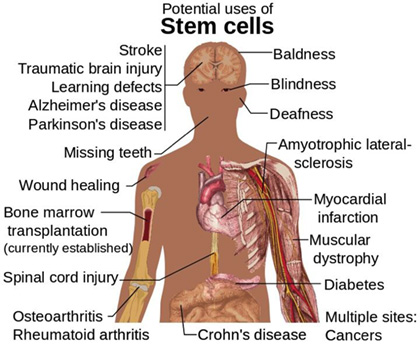 When there is an injury or a stress to an organ, compounds are released
that reach the bone marrow and trigger
the release of stem cells. Stem Cells can be thought of as master cells. Stem cells
circulate and function to replace dysfunctional
cells, thus fulfilling the natural process of maintaining optimal health
When there is an injury or a stress to an organ, compounds are released
that reach the bone marrow and trigger
the release of stem cells. Stem Cells can be thought of as master cells. Stem cells
circulate and function to replace dysfunctional
cells, thus fulfilling the natural process of maintaining optimal health
The health benefits of having more stem cells in the blood circulation have
been demonstrated by numerous scientific
studies. It would be too long here to summarize this vast body of scientific data.
I simply suggest you research the work of
Dr. Donald Orlic at the National Institute of Health.
Dr. Robert Sampson, MD on stem cell nutrition -
"... we have a product that has been shown and demonstrated in the
patent to increase the level of adult circulating stem cells by up
to 30%. It seems to me we're having a great opportunity here to
optimize the body's natural ability to create health."
The Amazing Power of Stem Cell Nutrition
Stem cells are defined as cells with the
unique capacity to self-replicate throughout the entire life
of an organism and to differentiate into cells of various tissues.
Most cells of the body are specialized and play a well-defined
role in the body. For example, brain cells respond to electrical
signals from other brain cells and release neurotransmitters;
cells of the retina are activated by light, and pancreatic ß-cells
produce insulin. These cells, called somatic cells, will never
differentiate into other types of cells or even proliferate.
By contrast, stem cells are primitive cells that remain undifferentiated
until they receive a signal prompting them to become various
types of specialized cells.

Dr. Cliff Minter - "Stem cells are the most powerful cells in the body. We know that
stem cells, once they're circulating
in the bloodstream, will travel to any area of the body that has been compromised or damaged and turn into healthy cells.
There have been controversial discussions about the new stem cells found in embryos, but the truth is that everyone has adult
stem cells in their own bodies. We are all created from stem cells.
As a child or a young adult, your body automatically
releases stem cells whenever you injure yourself. That's why you heal so fast when you are younger. After about age 35, we
don't heal as fast anymore, because the stem cells aren't released the same way as when we are younger. Stem cell nutrition helps
all of us heal our bodies. If you look at the New England Journal of Medicine, you'll find that the number one indicator of a
healthy heart is the number of stem cells circulating in the body. Stem cell nutrition is the organic and all-natural way
to stimulate the bone marrow to release adult stem cells into the bloodstream.
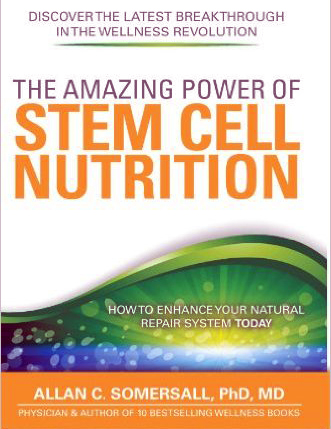 By taking stem cell nutrition, you can maintain optimum health and aid your body in healing itself. It's certainly a better
way to recuperate from an illness than using prescription drugs, because even when a medication works, it can often be hard on
your liver and the rest of your body. Stem cell nutrition has no negative side effects. This makes it a powerful approach
to healing and good health in general.
By taking stem cell nutrition, you can maintain optimum health and aid your body in healing itself. It's certainly a better
way to recuperate from an illness than using prescription drugs, because even when a medication works, it can often be hard on
your liver and the rest of your body. Stem cell nutrition has no negative side effects. This makes it a powerful approach
to healing and good health in general.
I found out about stem cell nutrition after someone asked for my opinion on it. I did
some research and found it to be one of the greatest ways to slow down aging that we have. Aging is nothing more than the
breakdown of cells. Stem cell nutrition combats that action. As cells break down, stem cell nutrition replaces them with
healthy cells. This is the greatest, most natural anti-aging method I know. I was skeptical at first, but the results I've
personally seen in people I've talked with have been wide-ranged. Lots of people have reported an increase in energy and better
sleeping patterns.
I've seen people with arthritis in various parts of their bodies reverse the disease, and people with asthma end up with
their lungs totally clear. One person that was on oxygen almost 24/7 is now totally off of oxygen. Two ladies who suffered badly
from PMS told me they were 100 percent symptom-free within weeks of starting the stem cell nutrition. Two people I know had tennis
elbow which usually takes about six to nine months to heal. Within weeks of taking stem cell nutrition, both report their
"tennis elbow" is gone. It makes sense, because stem cells go to whatever area is compromised and turn into healthy cells.
I use stem cell nutrition as a preventative. I've noticed an increase in my energy level and an improved sleeping pattern.
Stem cell nutrition has zero negative side effects, is very powerful, and we know how it works. It's good for children as
well as adults. This is the best, most natural way I know to optimum health. If you just want to use it for prevention, this
is the best thing I know for staying healthy. And if you do those and regaining optimum health. I recommend it to everybody."
Dr. Cliff Minter (retired) graduated from Illinois College of Podiatric Medicine. He completed his residency at the Hugar
Surgery Center in the Hines Veteran Administration Hospital in Illinois before going into private practice in Ventura, CA.
Dr. Minter is a national and international speaker on the subjects of business and nutritional products.
The Stem Cell Theory of Renewal
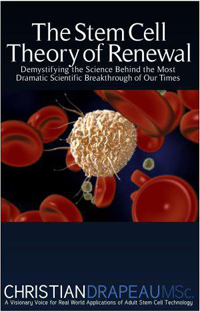 The Stem Cell Theory of Renewal proposes that stem cells
are naturally released by the bone marrow and travel via
the bloodstream toward tissues to promote the body's natural
process of renewal. When an organ is subjected to a process
that requires renewal, such as the natural
aging process, this organ releases compounds that trigger the
release of stem cells from the bone marrow. The organ also releases
compounds that attracts stem cells to this organ. The released
stem cells then follow the concentration gradient of these compounds
and leave the blood circulation to migrate to the organ where
they proliferate and differentiate into cells of this organ,
supporting the natural process of renewal.
The Stem Cell Theory of Renewal proposes that stem cells
are naturally released by the bone marrow and travel via
the bloodstream toward tissues to promote the body's natural
process of renewal. When an organ is subjected to a process
that requires renewal, such as the natural
aging process, this organ releases compounds that trigger the
release of stem cells from the bone marrow. The organ also releases
compounds that attracts stem cells to this organ. The released
stem cells then follow the concentration gradient of these compounds
and leave the blood circulation to migrate to the organ where
they proliferate and differentiate into cells of this organ,
supporting the natural process of renewal.
Most of the cells in the human body are specialists assigned
to a specific organ or type of tissue, such as the neuronal
cells that wire the brain and central nervous system. Stem cells
are different. When they divide, they can produce either more
stem cells, or they can serve as progenitors that differentiate
into specialized cells as they mature. Hence the name, because
specialist cells can "stem" from them. The potential to differentiate
into specialist cells whose populations in the body have become
critically depleted as the result of illness or injury is what
makes stem cells so potentially valuable to medical research.
The idea is that if the fate of a batch of stem cells could
be directed down specific pathways, they could be grown, harvested,
and then transplanted into a problem area. If all went according
to plan, these new cells would overcome damaged or diseased
cells, leading to healing and recovery. "The life of a stem
cell can be viewed as a hierarchical branching process, where
the cell is faced with a series of fate switches," Schaffer
says. "Our goal is to identify the cell fate switches, and then
provide stem cells with the proper signals to
guide them down a particular developmental trajectory."
Stem cells have the remarkable potential to develop into many
different cell types in the body. Serving as a sort of repair
system for the body, they can theoretically divide without limit
to replenish other cells as long as the person or animal is
still alive. When a stem cell divides, each new cell has the
potential to either remain a stem cell or become another type
of cell with a more specialized function, such as a muscle cell,
a red blood cell, or a brain cell.
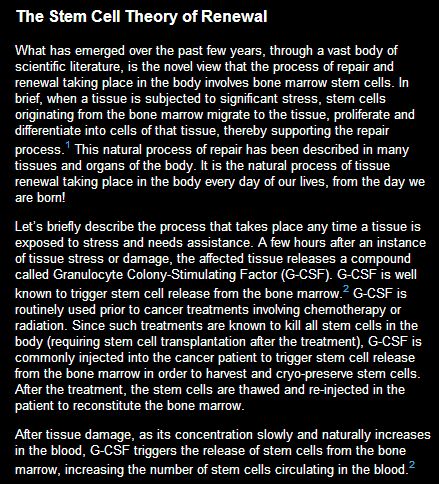 When a stem cell divides, each new cell has the potential to either remain a stem cell or become another type of cell with
a more specialized function. Scientists believe it should be
possible to harness this ability to turn stem cells into a super
"repair kit" for the body.
When a stem cell divides, each new cell has the potential to either remain a stem cell or become another type of cell with
a more specialized function. Scientists believe it should be
possible to harness this ability to turn stem cells into a super
"repair kit" for the body.
Scientist and author Christian Drapeau explains how the Stem Cell enhancers function to maximize
human performance - Supporting the release of stem cells from the bone marrow and increasing the number
of circulating stem cells improves various aspects of human health. For very active and sports focused people,
Stem Cells are the raw materials to repair micro-tears and micro-injuries created during training. The results,
according to Drapeau, are that active people, whether former NBA stars or amateur weekenders, can
exercise more intensely at each training session with the ultimate consequence of greater performance.
Theoretically, it should be possible to use stem cells to generate healthy tissue to replace that
either damaged by trauma, or compromised by disease. Among the
conditions which scientists believe may eventually be treated
by stem cell therapy are Parkinson's disease,
Alzheimer's disease, heart disease, stroke, arthritis,
diabetes, burns and spinal cord damage.

Stem Cell Nutrition Therapy in Veterinary Care
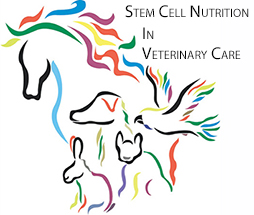 Both of my big dogs have gained their youth back. I am a true
believer in Stem Cell Nutrition for pets as it has provided a spectacular
change in both Ginger and Rowdy. Sonya, IN
Both of my big dogs have gained their youth back. I am a true
believer in Stem Cell Nutrition for pets as it has provided a spectacular
change in both Ginger and Rowdy. Sonya, IN
Stem cell nutrition for dogs, horses and other animals are
specially formulated to be a delectable treat for your animal.
The pet chewables and equine blends make it easy to provide
your animals with this valuable nutritional supplement. The
most common story is that of old, tired and sluggish dogs turned
— within a week or so — into active, alert dogs running around
like puppies. The same was observed in horses. Old horses who
used to remain standing in the barn or under a tree, sluggish
or stricken by too much discomfort to walk around, suddenly
began moving about, and at times running and bucking like young
colts. One of the most common reports was obvious improvements
in hoof health and coat appearance.

times. When there is an injury or a stress to an organ of your beloved
pet or horse, compounds are released that reach the bone marrow
and trigger the release of stem cells. Stem Cells can be thought
of as master cells. Stem cells circulate and function to replace
dysfunctional cells, thus fulfilling the natural process of maintaining
optimal health.
As they do in humans, adult stem cells reside in animals bone
marrow, where they are released whenever there is a problem somewhere
in the body. Looking back on stem cell research, we realize that
most studies have been done with animals, mostly mice, but also
with dogs, horses, pigs, sheep and cattle. These studies have revealed
that animal stem cells conduct themselves the same way human stem
cells do. When there is an injury or a stress to an organ of your
beloved pet or horse, compounds are released that reach the bone
marrow and trigger the release of stem cells. The stem cells then
travel to tissues and organs in need of help to regain optimal health.
Equine Stem Cell Nutrition
 Eve-Marie Lucerne - Eve-Marie keeps nine horses, all older
thoroughbreds, and was eager to participate in the trials of a new
stem cell enhancer for horses. She shared her allotment of test
products with a few large commercial thoroughbred farms, veterinarians
and other horse people she knows, and has been pleased with the
consistently excellent results she has seen and others have reported
to her. This product will help so many animals, she says, adding,
People and animals are more alike than we are different. So it makes
sense that a stem cell enhancer for animals with promote their health, too.
Eve-Marie Lucerne - Eve-Marie keeps nine horses, all older
thoroughbreds, and was eager to participate in the trials of a new
stem cell enhancer for horses. She shared her allotment of test
products with a few large commercial thoroughbred farms, veterinarians
and other horse people she knows, and has been pleased with the
consistently excellent results she has seen and others have reported
to her. This product will help so many animals, she says, adding,
People and animals are more alike than we are different. So it makes
sense that a stem cell enhancer for animals with promote their health, too.
Eve-Marie's Equine Stem Cells Nutrition show dramatic results. For several
horses facing serious physical challenges, cases where the animals
might have to be put down, we saw a return to quality of life. This
did not happen before Equine Stem Cell Nutrition. Eve-Marie says
that this turnaround was quick, less than two weeks in many cases,
and that the subject horses were back to health and enjoying pasture
life within a month. One of the unofficial trial subjects for the
equine stem cell nutrition was a 30-year old donkey who was in bad
shape, Eve-Marie reports. He had chronic
respiratory difficulty and could move about only haltingly. His
owner had stem cell enhancer supplements to help with her own serious
health challenges and shared it with the donkey. The donkey's owner
says this is the first time she wasn't sick, and her donkey is walking
all around, feeling great an enjoying life again!
Farrier and National Hoof practitioner Stephen Dick received
some of the trial product from Eve-Marie, and had good results with
the two horses he selected for trial. For a 12-year-old quarterhorse
stallion, the equine product brought dramatic results. This
horse used to lie down twenty-two hours of the day, because he suffered
discomfort whenever he stood, Steve reports, continuing, after a
couple of weeks with Equine Stem Cell Nutrition, he was getting
up and moving around, showing no discomfort. For a high-spirited
mare with a leg problem, the equine product brought about a whole
new lease on life, Steve says. This horse had been in a stall for
8 months. After about 6 weeks taking the equine product with her
grain, her condition had improved and she was out of the stall,
walking around in the pasture again.
 Little Joe, a small 18-year-old quarter horse that Judy Fisher
bought when he was nearly 400 pounds underweight. You could count
his ribs, Judy says, remembering, and his backbone stuck up like
a ridge all along his back. He was very, very thin! Little Joe also
suffered from breathing problems that kept him lethargic and inactive.
Vet-recommended remedies were unsuccessful in changing Little Joe's
physical problems, and the vet told Judy he didn't expect Little
Joe to live through the winter. I figured Little Joe was in such
bad shape that anything was worth a try, she says.
Little Joe, a small 18-year-old quarter horse that Judy Fisher
bought when he was nearly 400 pounds underweight. You could count
his ribs, Judy says, remembering, and his backbone stuck up like
a ridge all along his back. He was very, very thin! Little Joe also
suffered from breathing problems that kept him lethargic and inactive.
Vet-recommended remedies were unsuccessful in changing Little Joe's
physical problems, and the vet told Judy he didn't expect Little
Joe to live through the winter. I figured Little Joe was in such
bad shape that anything was worth a try, she says.
She began giving the horse stem cell nutrition with his feed and grain twice a day.
Within a couple of weeks, Judy was surprised to see Little Joe beginning
to gain weight and run, buck, snort and kick. His breathing was
no longer labored and his skin and coat were improving. Within six
weeks Little Joe's overall appearance had changed dramatically.
He had put on almost 300 pounds. When his former owner came to visit,
Judy says, he didn't recognize Little Joe. That's how different
he looked!
Sara participated in the
stem cell nutrition product trials with
her two horses and her 80-pound mixed-breed dog. She noted significant
improvement in the health and quality of life for all three animals
during the time of the trials. For JJ, Sara's 18-year old quarterhorse,
the equine product brought about improvements in his overall mood,
appearance and alertness quickly. He really liked the product from
the beginning, Sara reports, pointing out that Hank, her 16-year-old
thoroughbred/quarterhorse, had not taken to the taste of it too
readily. I was able to slowly wean him on it though, she says. For
Hank, the equine product was a balm for the skin problems
 resulting
from his allergy to fly bites.
resulting
from his allergy to fly bites.
His skin condition improved dramatically.
Sara reports, noting that before the equine product the horse had
scratched and bitten himself into ope wounds; after the equine product,
the scratching and biting dropped off to almost nothing. Sara also
noticed an increase in Hank's energy and liveliness in the first
week on the equine product. The horse's foot and hip discomforts
also responded well, leading to a noticeable increase in his mobility
and an overall improvement in his quality of life throughout the
two-month study.
Sara gave the pet product to her dog, Roxy, who
had suffered for two years with ear problems that led to scratching,
often until her skin was raw. Vet-recommended remedies had been
temporary, quick-fixes, Sara says, but the discomfort always returned
with a vengeance. For the pet trials, Sara gave Roxy two tabs of
the product a day for two months, noting this is the only supplement
she was getting. Sara says Roxy's problem with her ears definitely
improved, the hair as grown back on her head and ears, and the ear
problem has not recurred, adding that Roxy is happier and engaging,
more playful.

Health Science: Helping Your Body Heal Itself
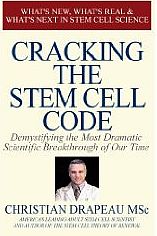 The National Health Institute lists seventy-four treatable diseases
using ASCs in therapy - an invasive and costly procedure of
removing the stem cells from one's bone marrow (or a donor's
bone marrow) and re-injecting these same cells into an area
undergoing treatment. For example, this procedure is sometimes
done before a cancer patient undergoes radiation. Healthy stem
cells from the bone marrow are removed and stored, only to be
re-inserted after radiation into the area of the body in need
of repair. This is a complex and expensive procedure, not accessible
to the average person. However, there is now a way that every
single person, no matter what their health condition, can have
access to the benefits of naturally supporting their body's
innate ability to repair every organ and tissue using stem cell nutrition.
The National Health Institute lists seventy-four treatable diseases
using ASCs in therapy - an invasive and costly procedure of
removing the stem cells from one's bone marrow (or a donor's
bone marrow) and re-injecting these same cells into an area
undergoing treatment. For example, this procedure is sometimes
done before a cancer patient undergoes radiation. Healthy stem
cells from the bone marrow are removed and stored, only to be
re-inserted after radiation into the area of the body in need
of repair. This is a complex and expensive procedure, not accessible
to the average person. However, there is now a way that every
single person, no matter what their health condition, can have
access to the benefits of naturally supporting their body's
innate ability to repair every organ and tissue using stem cell nutrition.
David A. Prentice, Ph.D. - "Within just a few years,
the possibility that the human body contains cells that can
repair and regenerate damaged and diseased tissue has gone from
an unlikely proposition to a virtual certainty. Adult stem
cells have been isolated from numerous adult tissues, umbilical
cord, and other non-embryonic sources, and have demonstrated a surprising ability
for transformation into other tissue and cell types and for
repair of damaged tissues.

Stem Cells Restore Memory in Mice
Experiments point to ways to treat injury, stroke and even Alzheimer's, experts say...
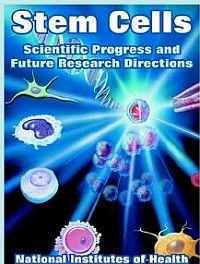 A new U.S. study involving mice suggests the brain's own stem cells may have the ability to restore memory after an injury.
These neural stem cells work by protecting existing cells and promoting neuronal connections. In their experiments, a team
at the University of California, Irvine,were
able to bring the rodents' memory back to healthy levels up to three months after treatment. The finding could open new
doors for treatment of brain injury, stroke and dementia, experts say.
A new U.S. study involving mice suggests the brain's own stem cells may have the ability to restore memory after an injury.
These neural stem cells work by protecting existing cells and promoting neuronal connections. In their experiments, a team
at the University of California, Irvine,were
able to bring the rodents' memory back to healthy levels up to three months after treatment. The finding could open new
doors for treatment of brain injury, stroke and dementia, experts say.
"This is one of the first reports that you can take a stem cell transplantation approach and restore memory," said lead
researcher Mathew Blurton-Jones, a post doctorate fellow at the university. "There is a lot of awareness that stem cells might
be useful in treating diseases that cause loss of motor function, but this study shows that they might benefit memory in stroke
or traumatic brain injury, and potentially Alzheimer's disease."
In the study, published in the Oct. 31 issue of the Journal of Neuroscience, Blurton-Jones and his colleagues used genetically
engineered mice that naturally develop brain lesions. The researchers destroyed cells in a brain area called the hippocampus. These
cells are known to be vital to memory formation and it is in this region that neurons often die after injury, the researchers
explained. To test the mice's memory, Blurton-Jones's group conducted place and object recognition tests with both healthy
mice and brain-injured mice.
Healthy mice remembered their surroundings about 70 percent
of the time, while brain-injured mice remembered it only 40
percent of the time. For objects, healthy mice recalled objects
about 80 percent of the time, but injured mice remembered them
only 65 percent of the time. The researchers then injected each
mouse with about 200,000 neural stem cells. They found that
mice with brain injuries that received the stem cells now remembered
their surroundings about 70 percent of the time -- the same
as healthy mice. However, mice that didn't receive stem cells
still had memory deficits.
 The researchers also found that in healthy mice injected
with stem cells, the stem cells traveled throughout the brain.
In contrast, stem cells given to injured mice lingered in the
hippocampus. Only about 4 percent of those stem cells became
neurons, indicating that the stem cells were repairing existing
cells to improve memory, rather than replacing the dead brain
cells, Blurton-Jones's team noted. The researchers are presently
doing another study with mice stricken with Alzheimer's. "The
initial results are promising," Blurton-Jones said. "This has
a huge potential, but we have to be cautious about not rushing
into the clinic too early."
The researchers also found that in healthy mice injected
with stem cells, the stem cells traveled throughout the brain.
In contrast, stem cells given to injured mice lingered in the
hippocampus. Only about 4 percent of those stem cells became
neurons, indicating that the stem cells were repairing existing
cells to improve memory, rather than replacing the dead brain
cells, Blurton-Jones's team noted. The researchers are presently
doing another study with mice stricken with Alzheimer's. "The
initial results are promising," Blurton-Jones said. "This has
a huge potential, but we have to be cautious about not rushing
into the clinic too early."
One expert is optimistic about the findings. "Putting in
these stem cells could eventually help in age-related memory
decline," said Dr. Paul R. Sanberg, director of the Center of
Excellence for Aging and Brain Repair at the University of South
Florida College of Medicine. "There is clearly a
therapeutic potential to this." Sanberg noted that for the process
to work with Alzheimer's it has to work with older brains. "There
is clearly therapeutic potential in humans, but there are a
lot of hurdles to overcome," he said. "This is another demonstration
of the potential for neural stem cells in brain disorders.".

Health Benefits of Stem Cell Nutrition
Dr. Nancy White Ph.D.- " I've always been interested
in health generally and in particular the brain, focusing on
the balance of neurotransmitters. I often do quantitative EEG's
for assessment of my patients. I'm impressed with the concept
of a natural product like stem cell nutrition that could help
release adult stem cells from the bone mass where the body would
have no objection and no rejection. I've tried stem cell nutrition
for general health anti-aging. After taking it for a time, I
fell more agile and my joints are far more flexible. I was astounded
while doing yoga that I was suddenly able to bend over and touch
my forehead to my knees. I haven't been able to do that comfortably
in probably twenty years. I noticed how much better my balance
has become. I believe stem cell nutrition is responsible for these effects,
because I certainly haven't been trained extensively in yoga. Also since taking stem cell
nutrition, I feel better and my skin is more moist and has a finer texture.
A bald friend of mine, who is also taking the stem cell nutrition, had several small cancers on top of his head. His doctor had
removed one from his arm already, and his dermatologist set a date to remove those from his scalp. Before the appointment,
my friend was shaving one morning and, looking in the mirror, saw that the cancers were all gone. They had disappeared within
a few weeks of starting the stem cell nutrition and his skin is better overall. Also, his knee, which he'd strained playing
tennis, was like new. Stem cell nutrition seems to go where the body's priority is. You never know what the affect is going
to be, but you notice something is changing. Another friend of mine seems to be dropping years. Her skin looks smoother
and her face younger. After about six weeks on the stem cell nutrition, she looks like she's ten years younger. A woman who
gives her regular facials asked what she was doing, because her skin looked so much different. Stem cell nutrition is remarkable
and could help anybody. Everybody should try it, because it's natural and there are no risks. As we grow older in years, we
still can have good health. That's the ideal. Even if you don't currently have a problem, stem cell nutrition is a preventative."
Dr. White holds a Ph. D. in Clinical Psychology, an MA in Behavioral Science, and a B.F.A. in Fine Arts, Magna Cum Laude. In addition,
she is licensed in the State of Texas as a Psychologist , a Marriage and Family Therapist and as a Chemical Dependency Counselor.
Fernando Aguila, M.D. - "Due to a heavy patient load, I have recently found that
I tire more easily, my legs are cramping,
and by the time I get home, even my shoulders and rib cage hurt. I knew I had to find a way to increase my stamina, energy and
vitality. A friend gave me information about stem cell nutrition and how it promotes the release of stem cells in the body. One
of the components apparently promotes the migration of the stem cells to tissues or organs where regeneration and repair is
needed most. My attention was drawn to the fact that it can increase energy, vitality, wellness, concentration, and much
more. It sounded just like what I needed. Since then, I've heard reports of people experiencing excellent results in a number
of different areas in their health. The improvements sounded dramatic. Because of all of their testimonies, I was willing
to believe it could promote wellness in the human body.
I tried stem cell nutrition myself. After a day, of hard work, I realized I wasn't tired at all, my legs were not aching,
and I didn't have any shoulder pain. I decided the stem cell nutrition must be working. I continued to take it, and was able
to work so efficiently and steadily that one surgeon commented that I was moving like a ball of fire. Stem cell nutrition gives
me support physically and mentally. I look forward to seeing what the major medical journals have to say about the studies
being done with this new approach to wellness."
Fernando Aguila, M.D., graduated from the University of Santa Thomas in Manila
, Philippines. He finished his internship at Cambridge City Hospital, Cambridge, MA and completed his residency at the New
England Medical Center in Boston, MA. He obtained a fellowship in OB-GYN anesthesia at the Brigham and Women's Hospital in
Boston and a fellowship in cardio-thoracic anesthesia at the Cleveland Clinic Foundation in Cleveland, OH.
Christian Drapeau is America's best known advocate for Adult Stem Cell science
health applications and the founder of the field of Stem Cell
Nutrition. He holds a BS in Neurophysiology from McGill University
and a Master of Science in Neurology and Neurosurgery from the
Montreal Neurological Institute.
One particular stem cell enhancers that was studied was found
to contain a polysaccharide fraction that was shown to stimulate
the migration of Natural Killer (NK) cells out of the blood into tissues. The same polysaccharide
fraction was also shown to strongly stimulate the activation
of NK cells. NK cells play the very important role in the body
of identifying aberrant or defective cells and eliminating them.
NK cells are especially known for their ability to detect and
destroy virally infected cells and cells undergoing uncontrolled
cellular division. The same polysaccharide fraction was also shown to stimulate macrophage activity.
Macrophages constitute the front line of the immune system.
They first detect an infection or the presence of bacteria or
virally infected cells, and they then call for a full immune
response. Adult Stem Cell Nutritional Enhancer also contains
a significant concentration of chlorophyll and phycocyanin,
the blue pigment in AFA. Phycocyanin
has strong anti-inflammatory properties and therefore can assist
the immune system.
The release of stem cells from the bone marrow and their
migration to tissues is a natural process that happens everyday.
Stem cell enhancers simply support that natural process and tips the balance toward
health everyday. It does not do anything that the body does
not already do everyday. So far, no instances of cancer or any
similar problem have ever been observed when using in vivo natural
release of stem cells from the bone marrow.
Each day, stem cells in the bone marrow evolve to produce
red blood cells, white blood cells, and platelets. These mature
cells are then released into the bloodstream where they perform
their vital life-supporting functions. When bone marrow stem
cell activity is interfered with, diseases such as anemia (red
blood cell deficit), neutropenia (specialized white blood cell
deficit), or thrombocytopenia (platelet deficit) are often diagnosed.
Any one of these conditions can cause death if not corrected.
Scientists have long known that folic acid, vitamin B12,
and iron are required for bone marrow stem cells to differentiate
into mature red blood cells. Vitamin D has been shown to
be crucial in the formation of immune cells, whereas carnosine
has demonstrated a remarkable ability to rejuvenate cells approaching
senescence and extend cellular life span.
Other studies of foods such as blueberries show this fruit
can prevent and even reverse cell functions that decline as
a result of normal aging. Blueberry extract has been shown
to increase neurogenesis in the aged rat brain. Green tea
compounds have been shown to inhibit the growth of tumor cells,
while possibly providing protection against normal cellular aging.
Based on these findings, scientists are now speculating that
certain nutrients could play important roles in maintaining
the healthy renewal of replacement stem cells in the brain,
blood, and other tissues. It may be possible, according to these
scientists, to use certain nutrient combinations in the treatment
of conditions that warrant stem cell replacement
These studies demonstrate for the first time that various
natural compounds can promote the proliferation of human bone
marrow cells and human stem cells. While these studies were
done in vitro, they provide evidence that readily available
nutrients may confer a protective effect against today's epidemic
of age-related bone marrow degeneration.
Dr. Robert Sampson, MD on stem cell nutrition - "...
we have a product that has been shown and demonstrated in the
patent to increase the level of adult circulating stem cells
by up to 30%. It seems to me we're having a great opportunity
here to optimize the body's natural ability to create health."
Recent scientific developments have revealed that stem cells derived
from the bone marrow, travel throughout the body, and act to
support optimal organ and tissue function. Stem cell enhancers
supports the natural role of adult stem cells. Stem cell enhancer
are typically derived from certain edible algae that grows in fresh water.

Stem Cells and Aging: Expanding the Possibilities
The possibility that a decline in the numbers or plasticity of stem cell populations contributes to aging and age-related
disease is suggested by recent findings. The remarkable plasticity of stem cells suggests that endogenous or transplanted stem
cells can be ‘tweaked' in ways that will allow them to replace lost or dysfunctional cell populations in diseases ranging from
neurodegenerative and hematopoietic disorders to diabetes and
cardiovascular disease.
As you age, the number and quality of stem cells that circulate in your body gradually decrease, leaving your body more susceptible
to injury and other age-related health challenges. Just as antioxidants are important to protect your cells from free radical damage,
stem cell nutrition is equally important to support your stem cells in maintaining proper organ and tissue functioning in
your body.
Stem Cell Biology Section from the National Institute on Aging
Mahendra S. Rao, M.D., Ph.D.
A fundamental breakthrough in our understanding of nervous
system development was the identification of multipotent neural
stem cells (neurospheres) about ten years ago. Dr. Weiss and
colleagues showed that EGF (epidermal growth factor) dependent
stem cells could be harvested from different brain regions at
different developmental stages and that these could be maintained
over multiple passages in vitro. This initial finding has lead
to an explosion of research on stem cells, their role in normal
development and their potential therapeutic uses. Many investigators
have entered this field and the progress made has been astounding.
Frequently Asked Questions
How does an increase in the number of circulating stem
cells lead to optimal health?
Circulating stem cells can reach various organs and become cells
of that organ, helping such organ regain and maintain optimal
health. Recent studies have suggested that the number of circulating
stem cells is a key factor; the higher the number of circulating
stem cells the greater is the ability of the body at healing
itself. Scientific interest in adult stem cells has centered
on their ability to divide or self-renew indefinitely, and generate
all the cell types of the organ from which they originate, potentially
regenerating the entire organ from a few cells. Adult stem cells
are already being used clinically to treat many diseases. These
include as reparative treatments with various cancers, autoimmune
disease such as multiple sclerosis, lupus and arthritis, anemias
including sickle cells anemia and immunodeficiencies. Adult
stem cells are also being used to treat patients by formation
of cartilage, growing new corneas to restore sight to blind
patients, treatments for stroke, and several groups are using
adult stem cells to repair damage after heart attacks. Early
clinical trials have shown initial success in patient treatments
for Parkinsons disease and spinal cord injury. The first FDA
approved trial to treat juvenile diabetes in human patients
is ready to begin at Harvard Medical School, using adult stem
cells. An advantage of using adult stem cells is that in most
cases, the patients own stem cells can be used for the treatment,
circumventing the problems of immune rejection, and without
tumor formation.
Why do we hear much in the news about embryonic stem cells
and very little about adult stem cells?
The first human embryonic stem cells were grown in vitro, in
a petri dish, in the mid 1990s. Rapidly, scientists were successful
at growing them for many generations and to trigger their differentiation
into virtually any kind of cells, i.e. brain cells, heart cells,
liver cells, bone cells, pancreatic cells, etc. When scientists
tried growing adult stem cells, the endeavor was met with less
success, as adult stem cells were difficult to grow in vitro
for more than a few generations. This led to the idea that embryonic
stem cells have more potential than adult stem cells. In addition,
the ethical concerns linked to the use of embryonic stem cells
have led to a disproportionate representation of embryonic stem
cells in the media. But recent developments over the past 2-3
years have established that adult stem cells have capabilities
comparable to embryonic stem cells in the human body, not in
the test tube. Many studies have indicated that simply releasing
stem cells from the bone marrow can help support the body's
natural process for renewal of tissues and organs.
The bone marrow constantly produces stem cells for the entire
life of an individual. Stem cells released by the bone marrow
are responsible for the constant renewal of red blood cells
and lymphocytes (immune cells). A 25-30% increase in the number
of circulating stem cells is well within physiological range
and does not constitute stress on the bone marrow environment.
The amount of active bone marrow amounts to about 2,600 g (5.7
lbs), with about 1.5 trillion marrow cells. Stem cells that
do not reach any tissue or become blood cells return to the
bone marrow.
Effectiveness of stem cell "enhancers" was demonstrated in
a triple-blind study. Volunteers rested for one hour before
establishing baseline levels. After the first blood samples,
volunteers were given stem cell "enhancers"or placebo. Thereafter,
blood samples were taken at 30, 60 and 120 minutes after taking
the consumables. The number of circulating stem cells was quantified
by analyzing the blood samples using Fluorescence-Activated
Cell Sorting (FACS). Consumption of stem cell "enhancers" triggered
a significant 25-30% increase in the number of circulating stem
cells.

Stem Cell Research
- Mobilized stem cells have also been used in renewal
of cardiac tissue - Journal of Clinical Investigation
107, 1395-1402; Jun 2001
- Bone marrow stem cells have also shown the ability
to participate in renewal of retinal tissues - Nature
Medicine 8, 1004-1010; Sep 2002
- Stem cells can form cartilage and bone - Science
(the world's leading journal of original scientific research)
284, 143-47; 2 Apr 1999
- Bone marrow stem cells can form liver, skin and digestive
tract cells - New England Journal of Medicine 346, 738-746,
7 Mar 2002
- Bone marrow stem cells can participate in cutaneous
healing, contributing to wound healing - Journal of
Cellular Physiology 196, 245-250; 2003
- Stem cells participate in the generation of new neurons
within the human brain - Proceedings of the National
Academy of Sciences USA 100, 1364-1369; 4 Feb 2003
- Bone marrow derived stem cells have been shown to
contribute to renewal of gastrointestinal tissue in human
patients - Archives of Dermatology 137, 1071-1072; Aug
2001
- Bone marrow stem cells can participate in restoring
kidney tissue - Journal of the American Society of Nephrology
14, S48-S54; 2003
- Repopulation of liver cells from bone marrow stem
cells could take place in humans - Nature 406, 257;
20 July 2000
- Bone marrow derived stem cells have also demonstrated
the ability to induce renewal of the pancreas - Bone
Marrow Transplant 215-222; Aug 2002
- Mobilized stem cells have also been used in renewal
of cardiac tissue - Journal of Clinical Investigation
107, 1395-1402; Jun 2001
- Bone marrow stem cells have also shown the ability
to participate in renewal of retinal tissues - Nature
Medicine 8, 1004-1010; Sep 2002
- Stem cell patients showed significant improvements
in nerve conduction velocities, and showed maintenance or
slight improvement in bone mineral density - Bone Marrow
Transplant 215-222; Aug 2002, published by the NIH
- Bone marrow stem cells have also been shown to contribute
to Purkinje cells (Purkinje cells are brain cells that
science had believed are not generated after birth) - Proceedings
of the National Academy of Sciences USA 100, 2088-2093;
18 Feb 2003
- Bone marrow derived stem cells have also been shown
capable of renewing muscle tissue - Science 279, 1528-1530;
Mar 6, 1998
- Bone marrow derived stem cells can renew cardiac
tissue and improve cardiac performance in humans- Nature
Medicine 7, 430-436; April 2001
- Studies indicate evidence that bone marrow stem cells
can renew lung tissue - Development 128, 5181-5188;
December 2001
- Stem cells can home to lung tissue, then participate
in renewal of lung tissue and reduction of inflammation
- Proceedings of the National Academy of Sciences USA 100:
8407-8411; 8 July 2003
- Human marrow stem cells have been shown to form cartilage
cells - Proceedings of the National Academy of Sciences
USA 99, 4397-4402; 2 Apr 2002